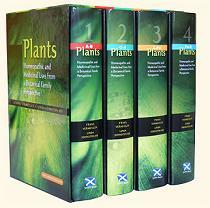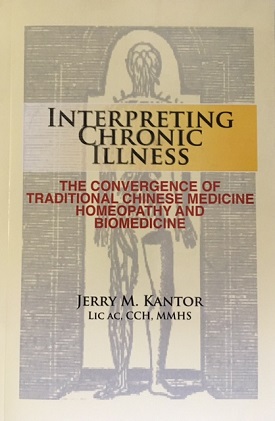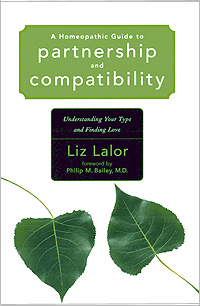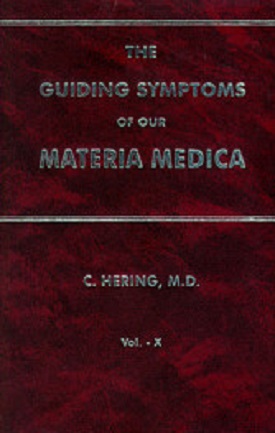PLANTS (a four-volume set … a “magnum opus!” by FRANS VERMEULEN and LINDA JOHNSTON, MD, DHt. [#VERPLA]
$490.00
Description
This book requires a “special order” and as such, it is not returnable once we place a special order for a customer.
Frans Vermeulen is widely recognized as the leading author of MODERN homeopathic materia medica, and his various books represent the cutting edge of homeopathy and its synthesis with scientific information, anthropological information, and modern life.
Linda Johnston, MD is a respected physician and homeopath who has received extensive training with George Vithoulkas, V. Ghegas, and Rajan Sankaran.
This new set of four volumes of materia medica on plant remedies represent the cutting edge of homeopathic information. 4,968 pages!
Plants are the largest section in both the homeopathic materia medica and traditional medicine. The various materia medica and repertories list over 2000 plants remedies, but the amount of information available on which to base prescriptions is sparse at best. This major work details over 2000 individual plant remedies classified in 150 botanic families.
Drawing on a wealth of information from provings, clinical observations, herbal uses, folk lore, mythology, botany, personal accounts, toxicology and other sources, the authors weave an in-depth, coherent picture of each botanic family and its members. Each family’s themes and organ system affinities are discussed, supported by the plants’ chemical composition, physiological and pharmacological effects. Combining the clarity and detail for which Frans’ work is renowned with Linda’s years of clinical experience promises to deliver a definitive text on plant remedies.” The works of Frans Vermeulen are among the most popular homeopathic books worldwide.
Each family’s themes and organ system affinities are discussed, supported by the plants’ chemical composition, physiological and pharmacological effects. In addition, for each plant remedy, PLANTS, lists the number of rubrics in modern repertories, as well as phytochemical composition, official and common names, botanical descriptions and distribution.
“…A wonderful development in recent years has been the recognition of the shared characteristics of remedies in groups…In PLANTS, we have chosen to divide plants into their most up-to-date botanical divisions…Throughout the process of writing this book we have had three main missions, those of being the Corrector, Collector and Connector. Firstly, a great deal of information, especially plant identities, names and family memberships, had to be corrected. Secondly, botanical, medicinal, historical and symptomatological information was collected…Finally, all the divergent information was connected to form a unity, a whole, an integrated life and therapeutic character of each grouping.”
From the introduction by Frans Vermeulen and Linda Johnston, MD
About the authors
Frans Vermeulen is recognised throughout the homeopathic world as an author, lecturer and authority on materia medica. Each of the many books he has authored makes a contribution of major significance to our understanding of substances and materia medica. His lectures are inspiring and appreciated for their liveliness, depth of knowledge and breadth of factual information.
Born in Den Helder, Holland, Frans taught at an elementary school from 1970 to 1978. From 1976 – 1983 he pursued his homeopathic education, while beginning his own practice in 1979. At this time, he had begun to translate homeopathic books by masters such as Kent, Allen, Tyler, Vithoulkas, and many others. In 1985 he wrote Kindertypes in de Homoeopathie (Children types in Homoeopathy) (Sonntag, 1988), based on his experiences as both a teacher and a homeopath.
In 1992 he wrote Synoptic Materia Medica I (Emryss, 1992), providing a materia medica overview as well as a quick and compact reference. This was followed by the Concordant Materia Medica (Emryss, 1994), which was enlarged in 1997 to include Hering’s Guiding Symptoms. Synoptic Materia Medica II (Emryss, 1996) broke new ground by focusing on small remedies and the correlations between the sources of the homeopathic remedies and how they relate to the drug pictures. Furthering that theme, Prisma (Emryss, 2002) takes data from non-homoeopathic sources as both reference material for the homoeopathic materia medica and as the source of potential symptoms. Frans’ two most recent books are Kingdom Monera and Viruses (Emryss, 2005) and by Kingdom Fungi (Emryss, 2007)
Now, after five years in the making, Frans is finishing his book on Kingdom Plants. Co-authored by his wife, Dr. Linda Johnston, the book discusses over 2000 plant remedies in 149 families following the latest classification system, APG II. Family themes are elucidated based on botanical classifications, phytochemicals, botany, traditional uses, folklore, history and many other sources, further supported by homeopathic information from provings, cases and other materia medica sources.
_________
Dr Linda Johnston has been a active member of the homeopathic community worldwide since the inception of her homeopathic practice in 1986. After completing her medical training from the University of Washington, USA in 1979, she had one further year in family medicine. She started her own private medical practice in 1981. Linda began her homeopathic training in 1986, and began practicing the same year. Linda’s main focus has always been her clinical practice of homeopathy, which she continues to this day.
Contributing to the homeopathic community through writing and teaching are both important to Linda. From 1991 – 1996, she developed and taught a two-year homeopathy curriculum in 4 different US cities to train licensed medical practitioners. She is also a well-known teacher internationally.
Author of numerous articles for homeopathy journals, Linda is also the author of Additions to the Homeopathic Repertory from Kent’s lectures on Homeopathic Materia Medica (Christine Kent Agency, 1990) as well as a popular book for the general public, Everyday Miracles: Homeopathy in Action (Christine Kent Agency, 1991) and her most recent work The Child’s World (Saltire Books, 2010 – more info here). Since her debut public lecture in 1987, she has made hundreds of radio, television appearances, in addition to print media interviews educating the public about homeopathy.
An excerpt from the books…ultimately, this excerpt verifies that this set of books will educate readers to the modern plant family designations…
As valuable as it is to group remedies together using certain criteria, we must also fulfill homeopathy’s prime mandate of individualisation. Hahnemann wrote in his Organon, aphorism 119: ‘As certainly as every species of plant differs in its external form, mode of life and growth, in its taste and smell from every other species and genus of plant, as certainly as every mineral and salt differs from all others, in its external as well as its internal physical and chemical properties [which alone should have sufficed to prevent any confounding of one with another], so certainly do they all differ and diverge among themselves in their pathogenetic – consequently also in their therapeutic – effects.’
Hahnemann continues by saying in a footnote that ‘Anyone who has a thorough knowledge of, and can appreciate the remarkable difference of effects on the health of man of every single substance from those of every other, will readily perceive that among them there can be . . . no equivalent remedies whatever, no surrogates.’ In Hahnemann’s view it was ‘undoubtedly the pure truth’ that ‘we ought to distinguish medicines carefully’. While certainly true theoretically, the reality of everyday practice is different. In order to distinguish medicines as carefully as Hahnemann’s ideal, two things are required, which are accurate botanical knowledge to differentiate plants and astute scrutiny to observe the smallest individual differences in what plants can cause or cure.
These are high demands, the realisation of which depends to a large degree upon the level of botanical science and an individual homeopath’s qualities of perception, knowledge and skill. Science in general has vastly improved since the days of Hahnemann, including huge advances regarding the biology, chemical properties and systematics of plants. In Hahnemann’s day plant classification or taxonomy and the naming of plants or nomenclature were both in their very early stages of development and still far from systematically consistent. This explains why so many of the old plant remedy names are not conform the currently accepted, formal system of binomial nomenclature in which the first name indicates the genus and the second denotes the species. For instance, Belladonna is used instead of Atropa belladonna, Stramonium instead of Datura stramonium, Dulcamara instead of Solanum dulcamara and Tabacum instead of Nicotiana tabacum. This is a crucial point to understand. Genus refers to ‘general’ and species refers to ‘specific’. This principle is easy to recognise when it is applied to people’s names. Genus would be a family name, such as Smith and the species would be the individual name of each family member. In the Smith family or ‘genus’ there might be 5 members or ‘species’ such as John, Mary, Sarah, David and Sam. The binomial naming system would result in John Smith, Mary Smith and so forth. This convention of naming means that once hearing the name, it is known that the person is an individual in the Smith family. The same is true with the binomial naming of plants. Their genus or general group is evident as well as their individual designation. There are certain characteristics that belong to the family, such as the home address, relationships, habits and culture and certain qualities that belong exclusively to the individual that differentiate them from other members. When looking for the Smith’s address, it is possible to use the genus Smith, but if you want to contact a distinct individual, there is no option but to use the species. It would be folly to suppose that John is the same as Mary in the same way that plant species within a genus would be interchangeable with another.
Having two names provides great help in the complementary processes of assembling and separating. The genus name helps to congregate, the specific name to segregate. For example, knowing that Stramonium is Datura stramonium would facilitate identification of Datura metel and Datura ferox as the remedies most closely related and thus the first options for comparison. Likewise, recognising that Dulcamara is Solanum dulcamara means that it is a species of Solanum being closest related to potato or Solanum tuberosum, tomato or Solanum lycopersicum and eggplant or Solanum melongena.
Other instances of old remedy names with just the genus name employed for designation are Thuja, Arnica, Lycopodium, Onosmodium and Bryonia, to list a few. No confusion is likely to occur as long as such a remedy is the sole representative of its genus, but that confidence is gone the moment a second species comes into play. There are two Thujas in the materia medica, both very similar in terms of chemical composition but a world apart morphologically. Arnica montana is European, but the fact that a plethora of other Arnica species are native to western North America has led to erroneous statements in the literature that Arnica montana can be found in North America. There are two Bryonias in the materia medica, Bryonia alba and Bryonia dioica. At one time they were believed to be interchangeable so that the symptoms of the latter are included with the former. The Bryonia pair is an example of the confounding of species sharing the same genus. Despite Hahnemann’s self-evident truth that ‘there can be no equivalent remedies’, interchangeability of remedies occurs frequently in homeopathy. For various reasons, the idea arose that different species, especially within the same genus, could replace each other. There is plenty of evidence for this in the materia medica. Species in the following genera have been mistaken for each other or were employed interchangeably – Aloe, Bryonia, Cinnamomum, Cypripedium, Helonias, Lilium, Magnolia, Melilotus, Origanum, Polygonatum, Polygonum, Rhus, Tilia and Trillium. In light of this, it must be concluded that traditional homeopathic prescribing took place on a generic rather than a specific level. In other words, prescribing has been on a level less individualistic than is usually assumed. Moving to methods that require more specific information and precision has been part of the impetus for more accurate botanical information. In addition to the absence of binomial names, there is a significant number of plant names listed in homeopathy that are inaccurate, misspelled, mistaken or misidentified. From our work, we have found that 30–35% of homeopathic botanical names are not in line with those of the source substances. Another critical issue concerns plant identity, which is of vital importance, especially now that characteristics of botanical families are playing an increasing part in remedy selection.
The ongoing development of plant sciences means that species are reassigned to other genera and sometimes even to other families than where the homeopathic literature places them. Plant systematics in homeopathy mostly follow the taxonomic classification systems of either Cronquist or Dahlgren. Both systems originated in the 1960s and were based on the morphological, anatomical and cytological features and other external characters of plants. The Cronquist system particularly was widely accepted and used for decades until detailed genetic evidence became available. This new knowledge arose in the late 1990s with the Angiosperm Phylogeny Group, or APG, comprising an international group of systematic botanists. They clarified and authenticated the relationships of flowering plants or angiosperms based upon phylogenetics, which is the study of evolutionary relatedness among groups of plants. A new classification system was established on the basis of molecular protein and DNA sequencing and genetic data, which confirmed or clarified some relationships in existing classification systems, but radically changed others. The first publication of the new system, APG I, appeared in 1998, with later updates to APG II in 2003 and to APG III in 2009. The beauty and advantage of APG is that genetic underpinning of plant systematics results in pharmaceutical alignment of plant species according to their chemical constituents. The American taxonomist J.B. McNair predicted the significance of such systematics as early as 1935 in his paper titled Angiosperm Phylogeny on a Chemical Basis: ‘Plants can be classified chemically in accordance with the substances made by them. Such a chemical classification may be compared with or used as a supplement to morphological classification and may be of some importance in the development of the true natural system of angiosperm phylogeny.’ Implementation of APG and the delineation of phytochemical composition greatly benefit homeopathic systematics. It must not be forgotten that nearly all traditional provings of plant remedies were carried out with tinctures, very low potencies or the crude substances, in order to elicit physiological actions and reactions rather than dynamic ones.
Most homeopaths are unaware of how much of the homeopathic materia medica of plants is actually based on herbal use, tinctures and unpotentised source material. From our investigations, we estimate that about 75–90% of plant symptoms are in this category. This is not to say the information should not be used, but only that we should be aware of exactly what kind of information we are relying upon. The biological effects produced in such manner obviously depend upon the chemical constituents of the plants tested. Phylogenetically closely allied plants, grouped in families, are chemically and pharmacologically very alike and thus by definition must be very similar in the symptoms they cause or cure. Belladonna, Hyoscyamus, Stramonium and Mandragora of the Solanaceae so much resemble each other because their chemicals are very alike. Yet, for homeopathic purposes, they are distinct remedies because further details differentiate them from each other. Similar patterns can be observed in all other families of which the phytochemistry has been investigated. It was said of the radical re-assignments and realignments proposed by APG that the taxonomic stability was ‘rudely shattered’. This can equally be said of the effects it may have on homeopathic classification. Yet, correct classification and placement of remedies is essential for accurate differential diagnosis. Some examples:
• Gelsemium has been removed from the Loganiaceae or Nux vomica family and placed in a family of its own. Because Gelsemiaceae is most closely allied to Apocynaceae, both botanically and symptomatologically, it is included with this family.
• Curare has been removed from the Loganiaceae and included in the Menispermaceae due to similarity of chemical composition and biological effects with the latter family.
• Anagallis and Cyclamen have parted company with Primula in their former family Primulaceae and are now part of Myrsinaceae.
• Many genera of the previously large family Scrophulariaceae have been transferred to other families. Digitalis, Gratiola and Veronica are now in Plantaginaceae; Euphrasia and Pedicularis are in Orobanchaceae; while Buddleja, Scrophularia and Verbascum came to or remained in Scrophulariaceae.
• A number of genera in the former Verbenaceae, such as Vitex [agnus-castus], have been moved to Lamiaceae.
• Aletris farinosa, previously part of Melanthiaceae in Liliales, has been reassigned to Nartheciaceae in Dioscoreales.
• Trillium and Paris previously belonged to Trilliaceae, but are now placed in the Melanthiaceae or Veratrum family.
• The genus Pulsatilla has disappeared. The former Pulsatilla species are now Anemone species.
• The genus Ledum has been dissolved, most species now being placed in Rhododendron.
• Great changes have taken place within Liliales, or Liliiflorae as the order was named in the Engler system of the 1920s. At one time the order Liliales was considered in homeopathy to be one of the largest groups of remedies. On the basis of molecular and morphological evidence, the redefinition of the group has resulted in the exclusion of Asparagales and Dioscoreales as separate orders, each with a number of families formerly lumped with the Liliales.






Reviews
There are no reviews yet.